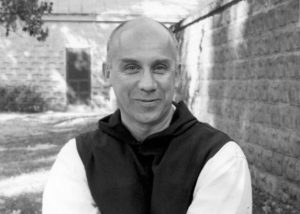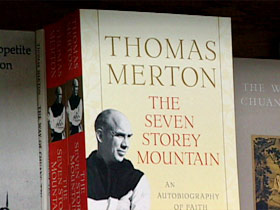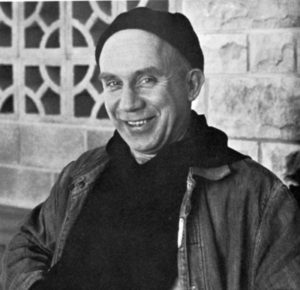11 Jan Beyond The Seven Storey Mountain: Remembering Thomas Merton
At the beginning of his autobiography The Seven Storey Mountain, Thomas Merton introduces himself thus: “On the last day of January 1915, under the sign of the Water Bearer, in a year of a great war, and down in the shadow of some French mountains on the border of Spain, I came into the world.” This book made him famous: a paradox for someone whose professed desire was to become hidden in God.
Merton’s life was full of paradox and contradiction. He was an extroverted New Yorker (in the words of his friend Ed Rice, “the noisiest bastard” Rice had ever met) who entered the silent world of the Trappist monastery of Gethsemani in the back woods of Kentucky. In making this choice, he left behind his ambition to become a writer only to have Gethsemani’s abbot sit him down at a typewriter. He had turned his back on the world and its temptations, and eventually discovered that the world, with all its beauty and flaws, was where he actually lived. Deeply attracted to women and not above using them, he forsook female companionship in becoming a monk, only to fall in love with a young woman at the age of fifty-one—and then acknowledging that the vowed celibate life was the right path for him. He sought solitude in a hermitage even as his gaze turned outward toward society’s evils: war, violence, injustice. Profoundly Christian, he discovered toward the end of his life the spiritual riches of eastern religions.
 The Seven Storey Mountain was published in 1948 and became an immediate best-seller. Merton was thirty-three and had been at Gethsemani for seven years. He knew that fame was illusory and he carried it lightly (referring to the book as “The Seven Storey Molehill” in one letter), but ruefully admitted in his journal that he imagined the popular movie actor Gary Cooper as the star of the autobiography’s film version.
The Seven Storey Mountain was published in 1948 and became an immediate best-seller. Merton was thirty-three and had been at Gethsemani for seven years. He knew that fame was illusory and he carried it lightly (referring to the book as “The Seven Storey Molehill” in one letter), but ruefully admitted in his journal that he imagined the popular movie actor Gary Cooper as the star of the autobiography’s film version.
The book covered his peripatetic childhood and adolescence: his mother’s early death and the subsequent shunting of him and his younger brother back and forth from France to New York and points beyond, as his restless artist father struggled to make a living. At school in England, he became an orphan at the age of fifteen when his father died of cancer. The final phase of his youth ended in disaster at the completion of his first year at Cambridge University. (The exact circumstances have never been explained, but bits of information strung together suggest a paternity suit.) Rootless and insecure, Merton landed in New York and enrolled at Columbia University. This was the beginning of a six-year odyssey that would lead him to Catholicism and Gethsemani Abbey.
Post-Mountain, Merton lived for only twenty more years. He died in Bangkok, at a meeting of monastic superiors when he was fifty-three. It was December 10, 1968, the twenty-seventh anniversary of his arrival at Gethsemani. In the last decade of his life he distanced himself from the author of his best-selling autobiography, explaining that it had been written when he was still in the first flush of conversion. Indeed, it has the ring of youthful judgementalism, and he is just as hard on his pre-conversion self as he is on the heathen beyond Catholicism’s gates (he even castigates himself as a six-year-old for not praying when he learns of his mother’s death).
His output over that twenty-year period is remarkable: dozens of books and articles. In the decades after his death, readers have been treated to the treasure trove found in his journals and letters. Among the most endearing of Merton’s legacies are the tape recordings of his talks to the younger monks. The tapes cover a wide range of subjects: monastic life, poetry, medieval and non-Christian mysticism, early Church teaching: whatever seemed to flow from his own prayer life and intellectual curiosity. He is not an orator.
“See?” he says every few minutes, like a tough guy in a 1930s movie
His voice is full of verbal tics (“see?” he says every few minutes, like a tough guy in a 1930s movie), bursts of laughter, and hints of impatience when he asks a question, doesn’t receive the answer he is looking for, and finally answers the question himself. In spite of the austere setting of the talks—it is a Trappist monastery, after all—Merton makes them sound as if he could be sitting in front of a fireplace with a beer (a beverage he was particularly fond of).
The question is sometimes asked: did Merton publish too much? Was the literary quality of his work sacrificed to quantity?  Some critics think so. Some others dismiss him because of what they perceive to be unmonklike behavior (the beer, the critiques of the nuclear program and racial inequality, the falling in love). But for those who take Merton seriously, each one has a favorite piece of writing, dog-eared, sentences underlined. Most can acknowledge as their own the searing honesty of the famous prayer that has been repeated in milieus as different as intentional communities, battle grounds, and prisons.
Some critics think so. Some others dismiss him because of what they perceive to be unmonklike behavior (the beer, the critiques of the nuclear program and racial inequality, the falling in love). But for those who take Merton seriously, each one has a favorite piece of writing, dog-eared, sentences underlined. Most can acknowledge as their own the searing honesty of the famous prayer that has been repeated in milieus as different as intentional communities, battle grounds, and prisons.
From his 1956 book Thoughts in Solitude, the prayer begins, “My Lord God, I have no idea where I am going.” It ends, “I will not fear, for you are ever with me, and you will never leave me to face my perils alone.”
–published in Bearings online, January 31, 2015, in honor of the centenary of Thomas Merton’s birth




